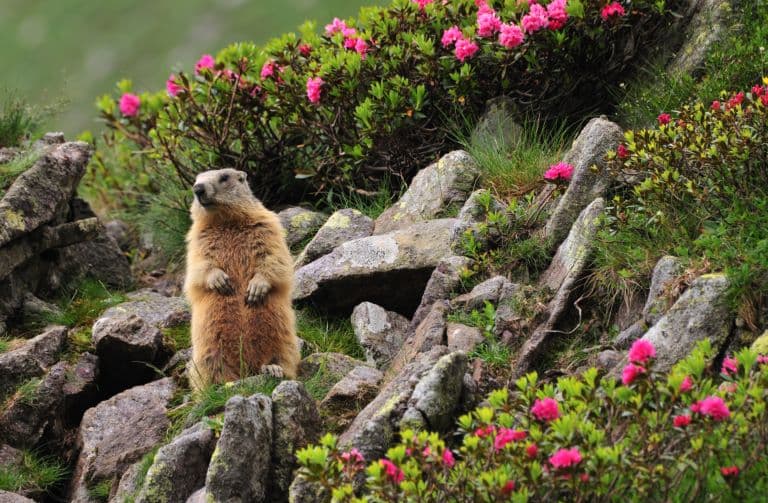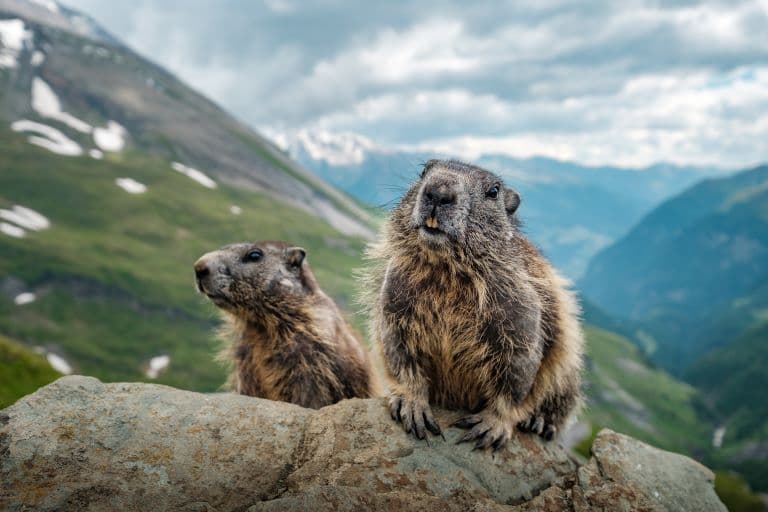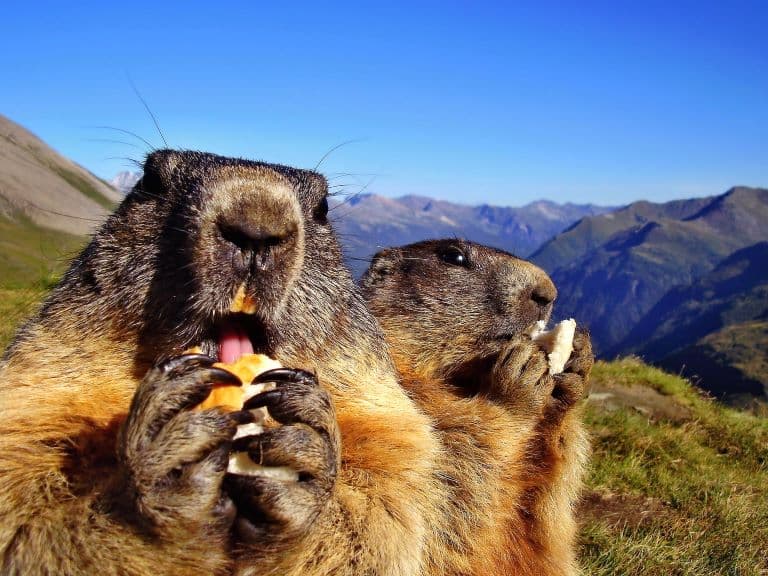Marmot Profile
When we think of squirrels, we typically think of the little tree-climbing variety that buries acorns in the garden and always look like they’re trying to remember something. And these are, indeed squirrels, but a decent third of all squirrel species wouldn’t dream of venturing up into the canopy.
The tribe of squirrels known as the ground squirrels take their name from quite an unpopular cocktail: the Marmotini.
The smallest of these are the chipmunks, who are actually quite good at climbing (and solving crimes), and at the other end of the size spectrum are the relatively giant marmots

Marmot Facts Overview
| Habitat: | Mountains or rough grassland plains |
| Location: | Asia, Europe, and North America. |
| Lifespan: | Up to 15 years |
| Size: | Up to 72cm long (28 in) |
| Weight: | Over 8kg (18lb), large species can reach 11kg (24lb) |
| Colour: | Squirrel coloured: browns, greys, some orange |
| Diet: | Flowers, buds, grasses, catkins, leaves, and twigs, sometimes insects |
| Predators: | Raptors, coyotes, cougars, bobcats, possibly bears |
| Top Speed: | 29 km/h (18 mph) |
| No. of Species: | 15 |
| Conservation Status: | Mostly Least Concern, some Vulnerable to Endangered (IUCN) |
Marmots are huge, burrowing ground squirrels, and the largest of the true hibernators. They’re very good at tricking their predators, but being so tasty, they still succumb to many and thus play an important role as a food source for various animals in their ecosystem.
But they also affect it directly, spreading seeds and improving soil drainage, and they are surprisingly speedy for such a chunky animal. Most are doing well, but Vancouver Island marmots are now in trouble due to human industrial impacts on their habitats.
Interesting Marmot Facts
1. They’re squirrels
Marmotini is comprised of groundhogs, prairie dogs, and other heavy squirrel species, including the genus Marmota, which makes up the 15 or so species of Marmot, spread across North America and Eurasia.
These are known for being able to stand fully erect for long periods, which is not as fun as it sounds, as they are the heaviest members of the squirrel family, at up to 8kg.
But it is useful, as, being ground squirrels, they spend most of their time on, and under, the ground.

2. They burrow
Marmot burrows are well-chambered tunnels of up to 9 meters long, designed to be difficult for animals who are not marmots to get into.
Marmots typically live in places where there are several large and medium-sized predators around, so security is a top priority. This is also why they are often so erect – it’s a great way to scan the plains for predators.
Burrows are excellent at protecting the animals from enemies and terrible weather, as well as maintaining a stable microclimate and improving drainage in the soil.
And this is pretty handy, as 80% of a marmot’s life will be inside one of these burrows; 60% of this subterranean existence will be spent hibernating. 1 2

3. They hibernate
Marmots are not only the largest squirrels, but the largest true hibernators. Some very pedantic people like to differentiate between the different types of torpor or reduced energy and temperature states.
Strictly, true hibernation needs to include a reduced metabolism, slower heart rate and lowered body temperature. Now, because the bear’s temperature doesn’t drop significantly during their Winter slumber, they are not entitled to this accolade. Marmots, however, are.
This makes them the biggest of the true hibernators, and marmots will spend up to 6 months chilling in their burrows waiting for the school year to end.
They have different burrows for this, and their housing is usually split between hibernating and living burrows, as well as perhaps a temporary burrow where they might go to get away from the kids for a week.
4. They’re important as a food source
That plethora of predators we just talked about is a constant threat to marmot well-being, and there’s only so much an erect marmot can accomplish with vigilance before he has to retreat into his burrow for safety.
But not all marmots are lucky in this, and this genus supplies a huge amount of food to its various predators.
For Olympic marmots, coyotes are one of the main threats, and for coyotes, at least a fifth of their diet is made out of marmots. But cougars, bobcats, raptors and even black bears will make a meal out of a marmot, which means they have evolved to be rather crafty in their evasion. 3
5. They’re smart
For the larger predators, like the coyotes and the cougars, stalking marmots can be tricky. Their general strategy is to get within 15 meters without being seen and then rush the poor bugger and hope to reach it before it sepulchres itself in the burrow.
The frustrated carnivore will then watch as the alarm calls of the escapee alert others to follow suit and soon all marmots are inaccessible.
Frantic digging at the entrance ensues, and the success of this is offset periodically when another individual pops out like whack-a-mole, releases a shrill cry and lures the bloodthirsty predator away from its task.
This process continues, and after running from burrow to burrow, the hunter finally gets the message and gives up in exhaustion.
So, marmots have to stay within a certain range of a bolt hole, which affects how far they can forage. And this is determined by how fast they can run. 4

6. They’re quite fast
It’s a scientific fact that 98.8% of “Animal top speeds” on the internet are delicately retrieved from the rectal cavity of either the writer themselves or an equally gassy and irresponsible source.
The truth is, nobody’s funding animal speed trials for science because the rankings aren’t all that important to the discipline.
Except for marmots, apparently. In a rare stroke of luck, a bunch of researchers were paid to scare the crap out of some marmots for science.
52 golden marmots were the subjects, and the justification for the abuse was that understanding how fast they are can give insights into how and why they forage at various distances from the safety of their burrows (this was, of course, a charade; but when you want science to pay for your weekend chasing marmots with the lads like Dr. Daniel T Blumstein, you do have to justify it to the funding body somehow).
The results were interesting. Dr. Blumstein found that the fastest average speed was just under 17 km/h, but only in females. Males were a little behind at around 15 km/h on average. One particularly frightened female was significantly faster than this at a measured 29km/h. 5
7. Vancouver Island marmots are struggling
Sadly, no species, marmot or otherwise is fast enough to evade the effects of human encroachment.
While most marmot species live in places where humans find it a bit chilly and are therefore still doing mostly okay, it’s an island species that’s showing the first sign of struggle.
Vancouver Island has a fairly picky list of requirements for its optimal existence, preferring good coil, sufficient rocks to burrow under and good lookout stumps that they can stand fully erect for long periods.
Colonies are quite small and limited to these locations, but while there is still quite a bit of viable habitat for them on the island, getting to it is proving to be difficult. Recently-logged areas are great for Summer burrows, but not suitable for hibernation. which might increase Winter mortality while also preventing marmots from reaching better habitats.
There’s an increase in predation that occurs in these locations, too, and this is said to be a major cause of the marmots’ decline, especially where invasive species are involved. 6

Marmot Fact-File Summary
Scientific Classification
| Kingdom: | Animalia |
| Phylum: | Chordata |
| Class: | Mammalia |
| Order: | Rodentia |
| Family: | Sciuridae |
| Genus: | Marmota |
Fact Sources & References
- Shu-Lin Wang (2021), “Burrow characteristics and ecological significance of Marmota himalayana in the northeastern Qinghai-Tibetan Plateau”, Wiley Online Library.
- Gerald E. Svendsen (1976), “Structure and Location of Burrows of Yellow-Bellied Marmot”, JSTOR.
- Nedergaard, Jan (1990), “Mammalian Hibernation”, Philosophical Transactions of the Royal Society of London.
- David P. Barash (1989), “Marmots: Social Behavior and Ecology”, Stanford University Press.
- Daniel T Blumstein (1992), “Multivariate Analysis of Golden Marmot Maximum Running Speed: A New Method to Study MRS In the Field”, Research Gate.
- “Vancouver Island Marmot”, IUCN Red List.
